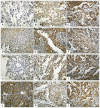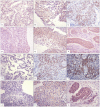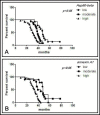Upregulation of Hsp90-beta and annexin A1 correlates with poor survival and lymphatic metastasis in lung cancer patients
- PMID: 22929401
- PMCID: PMC3444906
- DOI: 10.1186/1756-9966-31-70
Upregulation of Hsp90-beta and annexin A1 correlates with poor survival and lymphatic metastasis in lung cancer patients
Abstract
Background: Hsp90-beta and annexin A1 were investigated as prognostic factors because of their apparent association with tumorigenesis. However, the effect of Hsp90-beta and annexin A1 in lung cancer remains poorly understood. The expressions of Hsp90-beta and annexin A1 in lung cancer and normal lung specimens were examined, and the relationships with respect to the clinico-pathological features and patient survival in lung cancer were analyzed.
Methods: The expression levels of Hsp90-beta and annexin A1 were examined using immunohistochemistry, in-situ hybridization, and Western blot.
Results: Lung cancer tissues exhibited higher expression levels of Hsp90-beta and annexin A1 than the normal tissues (p < 0.05), and the expression levels of the markers were significantly associated with the pathological grade and lymphatic invasion of lung cancer (p < 0.05). Moreover, the upregulation of Hsp90-beta and annexin A1 correlated with decreased survival (p < 0.05).
Conclusion: The upregulation of Hsp90-beta and annexin A1 were associated with poor post-surgical survival time and lymphatic metastasis of lung cancer patients. Moreover, the high expression of the markers was an independent predictor of poor outcomes.
Figures






References
-
- Silistino-Souza R, Rodrigues-Lisoni FC, Cury PM, Maniglia JV, Raposo LS, Tajara EH, Christian HC, Oliani SM. Annexin 1: differential expression in tumor and mast cells in human larynx cancer. Int J Cancer. 200;120(12):2582–2589. 200. - PubMed
-
- Shen D, Nooraie F, Elshimali Y, Lonsberry V, He J, Bose S, Chia D, Seligson D, Chang HR, Goodglick L. Decreased expression of annexin A1 is correlated with breast cancer development and progression as determined by a tissue microarray analysis. Hum Pathol. 2006;37(12):1583–1591. doi: 10.1016/j.humpath.2006.06.001. - DOI - PubMed
Publication types
MeSH terms
Substances
LinkOut - more resources
Full Text Sources
Medical
Miscellaneous

